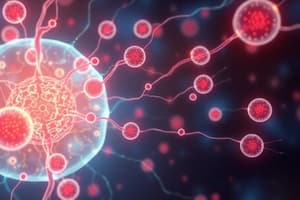Podcast
Questions and Answers
Which type of tonsils are located at the back of the throat and are commonly removed in surgery?
Which type of tonsils are located at the back of the throat and are commonly removed in surgery?
- Pharyngeal tonsils
- Lingual tonsils
- Hassall's corpuscles
- Palatine tonsils (correct)
The tonsils are fully encapsulated organs.
The tonsils are fully encapsulated organs.
False (B)
What is the primary function of the thymus in the immune system?
What is the primary function of the thymus in the immune system?
To produce T-cells and recognize normal T-cells from those attacking the body’s own tissue.
The ________ are lymphoid masses that filter bacteria in the pharynx.
The ________ are lymphoid masses that filter bacteria in the pharynx.
Match the following structures with their descriptions:
Match the following structures with their descriptions:
What is the primary function of the lymphatic system?
What is the primary function of the lymphatic system?
The spleen is located in the lower right quadrant of the abdomen.
The spleen is located in the lower right quadrant of the abdomen.
What type of immune response is associated with plasma cells?
What type of immune response is associated with plasma cells?
The lymphatic system serves as a pathway for absorption of fats from the ______ into the bloodstream.
The lymphatic system serves as a pathway for absorption of fats from the ______ into the bloodstream.
Match the following types of lymphocytes with their functions:
Match the following types of lymphocytes with their functions:
Which of the following is NOT considered an accessory organ of the lymphatic system?
Which of the following is NOT considered an accessory organ of the lymphatic system?
Red pulp in the spleen is primarily responsible for filtering microorganisms from the blood.
Red pulp in the spleen is primarily responsible for filtering microorganisms from the blood.
What are lymphatic ducts responsible for?
What are lymphatic ducts responsible for?
Flashcards
Lymphatic System
Lymphatic System
A vessel system connecting to the circulatory system, returning lymph cells to the bloodstream.
Lymph
Lymph
Clear, colorless, alkaline fluid that circulates through the lymphatic system
Lymphatic System Function (1)
Lymphatic System Function (1)
Returns fluids and proteins to the bloodstream, preventing fluid buildup in tissues.
Lymphatic System Function (2)
Lymphatic System Function (2)
Signup and view all the flashcards
Lymphocytes (role)
Lymphocytes (role)
Signup and view all the flashcards
Spleen Location
Spleen Location
Signup and view all the flashcards
Spleen Function
Spleen Function
Signup and view all the flashcards
Spleen Structure
Spleen Structure
Signup and view all the flashcards
Tonsil function
Tonsil function
Signup and view all the flashcards
Tonsil types
Tonsil types
Signup and view all the flashcards
Thymus location
Thymus location
Signup and view all the flashcards
Thymus role (simplified)
Thymus role (simplified)
Signup and view all the flashcards
Thymus structure (regions)
Thymus structure (regions)
Signup and view all the flashcards
Study Notes
The Lymphatic (Immune) System
- The lymphatic system is a vessel system connected to the circulatory system.
- It is composed of lymphatic capillaries, lymphatic vessels, lymphatic ducts, and lymph nodes.
- The lymphatic system returns lymph cells (clear, colorless, alkaline fluid) from tissue spaces back into the bloodstream.
Function of the Lymphatic System
- Transports proteins and fluids lost through capillary seepage back to the bloodstream.
- Protects the body against pathogens through phagocytosis and immune responses.
- Facilitates the absorption of fats from the small intestine into the bloodstream.
Lymphocytes
- Lymphocytes are prevalent in the lymphatic system.
- B-lymphocytes, when activated by an antigen, differentiate into plasma cells and B-memory cells.
- Plasma cells produce antibodies targeting and destroying pathogens (humoral immunity).
- T-lymphocytes, when activated by an appropriate antigen, differentiate into several types:
- Cytotoxic T cells (CD8+): kill virus-infected cells and tumor cells.
- Helper T cells (CD4+): activate B and T cells.
- Suppressor T cells: modulate the immune system.
- Memory T cells: influence the immune response.
- This process is called cellular immunity.
Immune Response
- The presentation of a metastatic carcinoma in lymph node (LN) is included.
Accessory Lymphoid Organs
- Spleen
- Tonsils
- Thymus
Lymphoid Organs (Locations)
- Primary Organs: Thymus, Bone Marrow
- Secondary Organs: Lymph nodes, Spleen, Peyer's patches, Appendix, Adenoids, Tonsils
The Spleen
- Located in the upper left quadrant of the abdomen.
- Major site of erythrocyte destruction and a reservoir for blood (emergency bleeding).
- Essential for immune responses and blood filtration.
Spleen Structure
- Composed of connective tissue stroma and parenchyma. The stroma is the framework (capsule, trabeculae, reticular CT)
- Parenchyma (soft tissue filling the framework): - White pulp: B-cell area (lymphoid follicles) and T-cell area (peri-arterial lymphatic sheaths). - Red pulp: Billroth cords, a soft tissue between white pulp and blood sinusoids. lymphocytes, erythrocytes, leukocytes, plasma cells, macrophages, and dendritic cells.
The Tonsil
- Lymphoid masses in the oral cavity and pharynx, filtering bacteria.
- Types: Palatine tonsils, Pharyngeal tonsils (adenoids), Lingual tonsils.
- Simplest lymphoid organs forming a ring of lymphoid tissue around the pharynx.
- Tonsil tissue contains follicles with germinal centers.
- Not fully encapsulated.
- Epithelial tissue invaginates to form blind-ended crypts that trap and destroy bacteria.
The Thymus
-
Located in the mediastinal cavity.
-
Crucial role in the development of the immune system in infants and young children.
-
Producing T cells (infection-fighting cells), essential to the immune system.
-
Helps distinguish normal T cells from those attacking the body's own tissues.
-
Consists of cortex and medulla:
- Cortex contains immature T-cells (thymocytes) and thymus epithelial cells, macrophages and dendritic cells
- Medulla contains mature T cells and thymus epithelial cells, macrophages and dendritic cells
-
Hassall's corpuscles (or thymic corpuscles): prominent structures in the thymus medulla, composed of concentrically arranged, often degenerated, eosinophilic epithelial reticular cells.
Studying That Suits You
Use AI to generate personalized quizzes and flashcards to suit your learning preferences.




